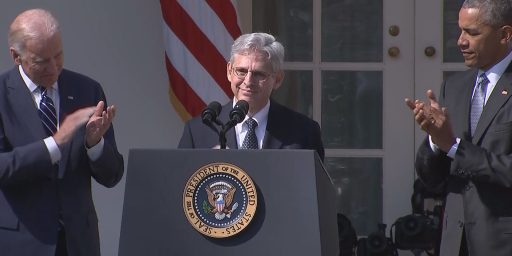RBG Speaks Out Against Court Packing Schemes
Ruth Bader Ginsburg isn't very impressed by the proposals made by several liberal politicians lately to increase the size of the Supreme Court to counterbalance the conservative tilt created by the Gorsuch and Kavanaugh confirmations.

Frustrated by the conservative swing of the Supreme Court that is likely to continue for some time to come, several Democratic candidates for President, Democrats on Capitol Hill, and Democratic-leaning pundits have spoken out recently in favor of various ways to reform the Supreme Court. Many of these ideas have included proposals to increase the size of Court, something that Congress could do without amending the Constitution, as well as other ideas.
Associate Justice Ruth Bader Ginsburg was asked about these proposals recently, and suffice it to say that she was not impressed:
Justice Ruth Bader Ginsburg said this week that she opposes proposals to expand the Supreme Court beyond its current nine members, a step that some Democratic presidential candidates have pushed as a remedy for what they see as the court’s lurch to the right under President Donald Trump and the Republican-controlled Senate.
“Nine seems to be a good number. It’s been that way for a long time,” Ginsburg told NPR’s Nina Totenberg.
“If anything, [it] would make the court look partisan,” she said of the court-packing plans advocated by some Democrats. “It would be that — one side saying, ‘When we’re in power, we’re going to enlarge the number of judges, so we would have more people who would vote the way we want them to.'”
Ginsburg also said she was not concerned by calls for term limits for justices, citing the political difficulty of amending the Constitution, which enshrines lifetime appointments for federal judges. She said Constitutional protections for the federal judiciary are so strong that “the safeguards for judicial independence in this country, I think, are as great or greater than any place else in the world.”
Several 2020 White House hopefuls have expressed interest in ideas to widen the court’s bench, fueled by liberal resentment over Senate Majority Leader Mitch McConnell’s refusal to hold confirmation hearings for Judge Merrick Garland, who was nominated to the high court in the final year of Barack Obama’s presidency.
The Volokh Conspiracy‘s Jonathan Adler directs us to these comments about the proposal from his co-blogger Ilya Somin:
I fully recognize that many Democrats regard court-packing as justified retaliation for the GOP’s “theft” of the Supreme Court seat that went to Neil Gorsuch as a result of the Republican-controlled Senate’s refusal to hold hearings and vote on Barack Obama nominee Merrick Garland. Republicans, in turn, argue that their treatment of Garland was justified by past Democratic misdeeds in the judicial nomination process (including refusal to hold hearings for a number of prominent GOP circuit court nominees), and that the Democrats themselves had signaled they would refuse to consider a GOP nominee in circumstances similar to those surrounding the Garland appointment. The truth is that, for a long time, both parties have shamelessly violated a variety of norms surrounding judicial nominations almost any time it seemed like they might gain an advantage to doing so. And both are equally shameless in shifting back and forth on procedural issues whenever the political winds dictate. The latest example is the contrast between GOP Senate leader Mitch NcConnell’s insistence, in 2016, that the then-open Supreme Court seat should not be filled until after the November election, and his current claims that the present vacancy must be filled quickly, and certainly before the GOP might potentially lose its Senate majority in this fall’s election.
But whatever we might think about the history of these shenanigans, court-packing is qualitatively different from any of them. Holding up nominees (as the GOP did with Garland), filibustering them (as the Democrats did with several Bush nominees, and as many – including Barack Obama – tried to do with Justice Samuel Alito), or “slow walking” them through the nomination process (many examples from both parties), are all potentially problematic. But all still leave the judiciary intact as a serious check on the power of the other branches of government. Court-packing, by contrast, would not. Once the norm against it is broken, both parties will resort to it whenever they have simultaneous control over Congress and the presidency, thereby foreclosing any significant judicial review of their policies.
When it was proposed last year, the Calabresi-Hirj plan sank like a stone. Even many on the right rejected it. That reaction showed the continued vitality of the norm against court-packing. But conservatives are likely to rethink their position if they believe liberal Democrats will pack the courts the first time they get a chance. And they will almost certainly do so (and retaliate in kind) if the Democrats actually do resort to court-packing the next time they get the chance.
Some liberal Democrats might still conclude that it’s better to blow up judicial review than to leave that power to be exercised by a Court with a conservative majority. This would be an understandable, but shortsighted reaction. For all their serious differences and very real flaws, mainstream liberal and mainstream conservative jurists still agree on many important questions, including protection of a wide range of freedom speech, basic civil liberties, and ensuring a modicum of separation of powers, among others. History shows that these are the sorts of restraints on government power that the executive (sometimes backed by Congress) is likely to break during times of crisis, or when they have much-desired partisan agendas to pursue. Such actions are especially likely if the president is a populist demagogue with authoritarian impulses. And, as the current occupant of the White House demonstrates, the safeguards against such people getting power are not nearly as strong as we might have thought before 2016. As specialists in comparative politics emphasize, it is no accident that court-packing is a standard tool of authoritarian populists seeking to undermine liberal democracy, recently used in such countries as Hungary, Turkey, and Venezuela.
(…)
Court-packing might still be attractive to people who believe that it’s more important to eliminate “bad” judicial review as an obstacle to beneficial policies, than to preserve the “good” kind as an obstacle to oppressive ones. That theory has advocates on both right and left. This longstanding issue cannot be fully settled in a blog post. But I believe the history of American government – and government elsewhere – shows we have more to fear from state oppression than from excessive exercise of judicial review. Given widespread voter ignorance and prejudice, majority public opinion – and the politicians it elects – often cannot be trusted to avoid deeply oppressive and unjust policies. Judicial review cannot prevent all such wrongs, but it has historically done a good deal to at least alleviate them.
Court-packing was a terrible idea when FDR advocated it in 1937 and when some conservatives pushed it last year. It remains a terrible idea today.
Ginsburg and Somin are, of course, both correct in their criticism of the ideas that have been advanced to pack the Court. First of all, as Ginsburg notes, and as I have noted myself on several occasions, while the Constitution leaves it to Congress to determine who big the Supreme Court should be, nine Justices seems to be an ideal number that allows the Court to function at its best.
One reason to be skeptical of these court-packing proposals is due to the fact that it would inevitably lead to a Supreme Court of more than nine members, potentially substantially more than nine depending on the circumstances. While it’s true that nine Justices is not holy writ, the fact that it has been the norm for most of the time that SCOTUS has existed is a strong indication either of the alternatives — shrinking the size of the Court or increasing it — could be problematic.
Shrinking the membership of the Court, of course, would mean that there would be far fewer voices to consider the issues that come before the Court. In this regard, it’s worth noting that, for the most part, the Supreme Courts on the state level have mimicked the custom we’ve had at the Federal level with a membership of nine justices, although there are some states that have fewer than that. (I am unaware of any State Supreme Court that has more than nine members.)
Another problem with the proposal to increase the size of the Court is that it is unlikely that it would be a limited matter. Democrats no doubt would love to increase the size of a court that looks as though it will be tilting to the right for the next several decades, so if they get control of Congress they would want to increase the size of the court to try to dilute the power of the conservatives. Republicans would no doubt want to do the same when they regain control of Congress and the White House. And so on, and so on. Where does it stop? How many SCOTUS Justices would be “enough?” 11? 13? 15? Obviously, it would have to be an odd number so as to avoid the problems that ensure in the case of an evenly divided court. At some point, though, I think the Court could get so large that it would have an impact on the effectiveness of body and the ability of the Court to do its job under Article III.
A very good example of the problems a much larger Court would create can be seen by looking at the Ninth Circuit Court of Appeals, the nation’s largest and busiest Court of Appeals. At present, there are 28 active Judges on the Court not counting those who have taken Senior Circuit Judge status. If you add in the 3 seats that are currently vacant, that makes for a membership of 31 Judges.
To a large degree, the 9th Circuit needs to be this big to deal with the sheer volume of appeals that come through its doors every year. One consequence of this, though, is that the court long ago ended the practice of having all of the active Judges participate when the Court sits en banc. Instead, if and when en banc review of a panel decision is granted it is assigned to an en banc panel consisting of 11 of the active Judges. This is not really what en banc review is supposed to be, and would be an impractical way for the Supreme Court to operate. This is one of the reasons why there have been many arguments made over the years to break up the 9th Circuit and create a new 12th Circuit Court of Appeals. So far, though, the various plans for how that would happen have been so far apart that Congress has not addressed the issue.
Looking around the world, the differences, and similarities, in how other nations staff their respective highest court is of interest:
- The United Kingdom has a Supreme Court made up of 12 members;
- Canada’s Supreme Court has 9 members;
- Australia’s High Court, which appears to be their equivalent to SCOTUS, has 7 members;
- New Zealand’s Supreme Court has 6 members;
- Ireland’s Supreme Court has 8 members;
- South Africa’s Supreme Court of Appeal has 22 members, but most cases are heard by panels made up of 5 Justices;
- Israel’s Supreme Court has 15 members.
That’s an average composition among nation’s that model their legal systems after English common law traditions at roughly 11 Justices. This puts the United States roughly in line with the rest of the world.
The final reason to oppose court-packing is the one that Somin mentions, namely the prospect that such a scheme would be likely to enhance the power of the state and authoritarian rulers like Trump. Indeed, as Somin documents, court-packing is a typical scheme engaged in by such rulers to assert control over the Judiciary. If the past two and a half years have shown anything, it is has shown us that the courts are still an effective check on abuses of power by the Executive Branch. Even Judges appointed by President Trump have issued rulings against Administration action because they are in clear violation of the law. A Judiciary packed with blatantly political nominees is unlikely to continue to serve that function, thus undermining the final restraint holding back authoritarian power.
Our current judicial system is admittedly not perfect, but it has served us well. We should listen to Justice Ginsburg and refrain from fooling with something that has worked for more than 200 years now.






That shipped has sailed… and it isn’t coming back.
Nope. Nothing you post actually says or supports this – other than we’ve done it that way for awhile. In fact, I would suggest that it is plainly and obviously insufficient to actually reflect the diversity present in a country as large and varied as ours. As a country, we have outgrown the numbers set decades ago in the House and in the Judiciary.
The number of circuits should be expanded and brought into more size equilibrium and balance and we should have a Supreme Court Justice that is assigned to each of these newly-balanced Circuits (reserving DC and the Federal Circuit for the Chief Justice). We expand the number of seats to both (1) increase the diversity or background/perspective thereby increasing the representative nature and grating legitimacy and (2) decrease the overwhelming importance of any single seat to reduce the chances of another Garland situation.
Right now, the two biggest attributes a White House with a same-party Senate looks to are (a) partisanship and (b) youth – not the overall caliber or experience of the nominee. It is both completely logical given the current structure and also insane from a good of the country perspective. Expanding the Judiciary overall, including the Supreme Court is both smart and anti-partisan.
Edited to add: Space the growth out over a number of years to minimize the “court packing” aspect if you wish but the current size and structure means that too many cases don’t get heard and too many voices aren’t represented.
As if the court isn’t already partisan…thankfully, if the Democrats are able to retake the presidency and the Senate, RBG will have no say in what they decide to do with the Supreme Court…
Oh really? I don’t see how decisions like Bush v. Gore and Citizens United, among many others, have served us well at all…
A larger number of judges but still with panels of 5,7 and 9 (depending on the case, like we have in Canada) selected in some fashion from the larger number would be pretty interesting. I think it might reduce politics.
@Pylon:
Panels that don’t include all the members of the Supreme Court would appear to me to not be authorized by Article III of the Constitution.
The most important reason to resist a court packing scheme is that it represents the admission that our society no longer functions. The American Experiment is over because we no longer have the ability to rule ourselves with equanimity and good will toward all of our citizens.
Of course, the American Experiment may well be dead.
@SKI:
I don’t think that the number of Circuits is at all relevant to the question of how many Supreme Court Justices there should be. The only connection between the Supreme Court and the Circuits is that each Justice is assigned a Circuit or Circuits for which they are responsible, mostly for considering emergency applications. In most cases, though the Justice in question ends up referring the petition to all of his or her fellow Justices for consideration. This is a responsibility that quite honestly doesn’t take up very much judicial time.
You can find the current list of Circuit assignments at the link.
@Doug Mataconis: You are right…and wrong. 🙂
No, it isn’t a required tie-in but, from an optics perspective, a political perspective, an attempt to keep an expansion that is necessary to achieve the preferred diversity and deescalation of partisanship (something I’ll note you chose not to address though it was more directly a challenge to your post) is more likely if structured as part of an overall restructuring of the Judiciary and not in isolation as a “court Packing plan”.
Assuming a Democratic president and Democratic control of the House and Senate in 2021, and assuming an end to the legislative filibuster, then what happen if the Democrats pass a law increasing the size of the court to, say, 11 Justices?
Naturally the GOP will scream and carry on as never before. And they’d even have a point, as now Generic Democrat gets two instant nominations, and swings the court from 5-4 to 5-6 against them. Then, if Generic has any political sense, they’d urge the older liberal justices to retire.
The Republicans couldn’t do anything until 2024 or 2028. Even if they manage to retake the House and Senate, they wouldn’t increase the court while Generic Democrat is able to nominate more Justices. But comes 2024 or 2028, and we get 15 justices (13 is bad luck). Who knows what the balance will be then.
Question: who benefits from a packing the Supreme Court arms race? I mean, beyond one or two presidential terms.
Game theory (and there’s been quite a bit of research on this) suggests that Tit for Tat is a pretty solid way to ensure cooperation in a repeated Prisoner’s Dilemma situation. However, in the Senate with regard to judges, it doesn’t seem to be working. I’m not sure why that is, but I have some thoughts.
What’s the measured retaliatory response to the Merrick Garland situation? There probably isn’t one available, not until the ‘shoe on the other foot” situation arises, and that could be another hundred years or so. So that’s maybe a problem – the timeline for these interactions is too long, it has little power to shape behavior because the feedback loop is too slow to facilitate learning.
Maybe there are other reasons, too. My take – and this might well be wishful thinking – is that Reagan conservatism, also known as Movement conservatism, is falling apart, and the focus on judges (and gerrymandering, etc) is the result of a “do anything to make this last a little longer”. Trump specifically repudiates several planks of movement conservatism. His supporters quite like their Medicare and Social Security, thank you very much. He’s a trade warrior, not a free trader. But the Republican establishment disagrees with him on this stuff, they are just keeping it quiet and stuffing as many friendly judges – who have been schooled on their ideology – into the courts as they can.
In short, the movement conservatives are facing an existential crisis, and as such, pay little attention to norms of behavior, as they have little expectation of survival in the long term. That explains their behavior, and it’s what I see. This attitude makes them super dangerous, don’t think I mean to wave them off as inconsequential.
But anyway, that’s why I don’t support the Democrats packing SCOTUS. We do not face an existential crisis, though we do face very severe testing of our resolve. Court packing would just hand another tool to those who do face such a crisis, and as such, they will use it more effectively and more efficiently.
@Doug Mataconis: I’m not opining on what’s constitutional or not. I assume that a lot of changes I’d make to your fine country require a constitutional amendment.
Practically speaking, smaller panels are beneficial in Canada because of things like certain appeals get to be heard as of right, mainly in the criminal sphere.
If you look beyond the Supreme Court, you will see that 8 years of refusing to confirm Obama’s judicial nominations, followed by 2.5 years of lockstep rapid confirmation of Trump’s nominees, has resulted in court packing already.
Also, if you look at the Supreme Court, you can see the same thing.
The ship has sailed on doing the “right” thing.
Nobody’s addressed that.
I’ve seen a claim that Ginsberg is wrong, that term limits could be imposed by legislation, perhaps with a retirement with full pay for life scheme along the lines of Senior judges, but not entirely voluntary.
Doug, where in Article 3 does it say that the supreme court cannot hear matters in panels of various sizes (so long as it is the court of last resort no matter what size the panel is)?
I miss the days when being a “liberal” was primarily about policy preferences rather than retaliating against the authoritarian-conservative complex by aping them. That ship has, admittedly, sailed, but it was nicer while it lasted.
I appreciate what Ginsburg is saying, but it won’t convince anyone.
It is ironic (actually, infuriating) that the party that has loudly complained about “activist judges” (a pointless term, since it really just means “judges I disagree with”) for decades basically now stands for nothing but tax cuts and packing every level of the court system with activists they approve of. They’ve literally given up on legislation in favor of rule by judicial fiat, as long as THEY get to choose the judges.
It would take a Constitutional amendment to do (which means it will never happen), but I would look to something radical to replace and repudiate the hash McConnell has made of things. The goal would be to make Supreme Court appointments less of a “prize” demanding total partisan lockstep. For example, what about appointing 1 Supreme Court justice every 4 years, regardless of vacancies? With an exception if the Court ever drops below 5 justices. Add that cases must be heard by the maximum odd number of judges available, up to 9. When more than 9 judges, or 6 or 8, are available, the judges to hear the case will be chosen randomly from among the current justices. Nominees require an up or down Senate vote within 3 months of nomination, and if 2 consecutive nominations are voted down then the government shuts down until the President and Senate agree on someone.
At levels lower than the Supreme Court you could still require nominations within 3 months, and up/down votes within another 3 months. Not sure of the best mechanism for preventing a party simply voting No on every nominee (or a President continually nominating extreme partisans). Maybe if a position is unfilled after 2 or 3 failed nominations then the decision is taken out of the President and Senate’s hands, and the Supreme Court itself will appoint someone 🙂
Basically trying to eliminate the electoral warfare around appointing judges that has become such a dominant and destructive force in our politics, while also avoiding accusations of court-packing. The whole appointments process (judicial and otherwise; how many “active” heads of departments do we have right now) is broken beyond belief at this point (thanks Mitch, you worse-than-useless *&%&^%&^%).
Oh yes, it’s much better for Democrats to just sit back and be punching bags for Republicans…that’ll really help this country move forward…